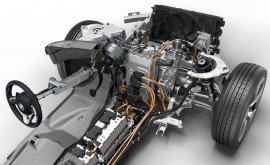All new cars come with warranties, but unfortunately they don’t cover absolutely everything that can go wrong with your car. One of the longest lasting warranties available is the powertrain warranty, but what exactly does it cover?
In simple terms, a powertrain warranty covers the parts of a car that provide power and make it move. Typically that involves the engine, transmission and drivetrain. If any of these components are found to be defective or damaged within a certain period of time, then the manufacturer will pay to have the bad components repaired or replaced. For additional repairs to other components, your new cars bumper-to-bumper warranty may have you covered, assuming it’s not expired yet.
Be warned though, powertrain warranties don’t usually cover those pesky wear items like clutches or CV joints and boots. These items wear out during the typical usage of your car so they don’t fall under warranty coverage. Other items like the battery aren’t covered either, but sometimes have their own specific warranty coverage.
Like other new car warranties, the powertrain coverage is limited in terms of time or mileage; whichever comes first. However, powertrain warranties are usually longer than other warranties, like the bumper-to-bumper coverage.
See Also: Should You Buy an Extended Warranty for Your Car?
Typically, automakers offer about 5 years or 60,000 miles of powertrain coverage. Some automakers like Hyundai, Kia and Mitsubishi extend that to 10 years or 100,000 miles. Essentially, if your car is older than the warranty coverage period or has more miles than allowed (whichever comes first), then those repairs won’t be covered.

Finally, don’t expect engine, transmission or drivetrain maintenance to be covered under a warranty. That means you’re on the hook for things like engine tune-ups and oil-changes.
In the past, powertrain warranties used to be a huge selling point, especially with domestic automakers that could promote their warranties as a way to boost buyer confidence in the products. These days though, it seems like the warranty isn’t as important anymore, leading to Chrysler and GM drop their warranty coverage down to five years/60,000 miles from 10 years/100,000 miles. Now only a few companies offer such long warranties. However, these 100,000 mile warranties do not transfer from the original owner of the car to a second-hand buyer. That means you shouldn’t expect a used model from these automakers to still boast the same long warranty as it did when it was brand new.
If you want additional warranty coverage on a used car, consider getting a certified pre-owned car. Automakers include powertrain and bumper-to-bumper warranties on their CPO cars, ensuring you have some extra peace of mind when it comes to a used vehicle.
See Also: Should You Buy a Certified Pre-Owned Car?
Powertrain warranties are advertised as being longer than other new car warranties, and as a result are quite limited in terms of coverage, so be wary of what automakers are promoting and what they mean for your long-term car care.








